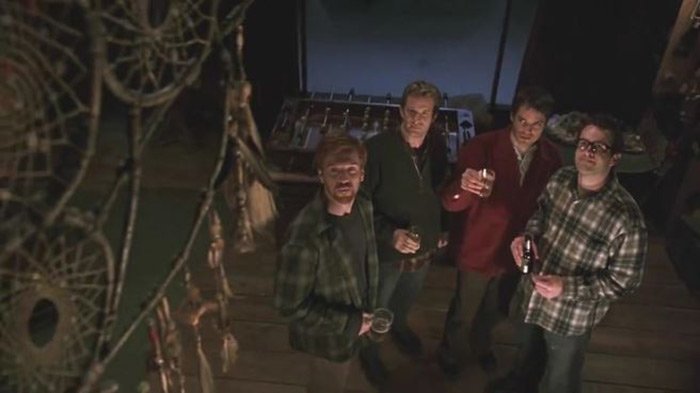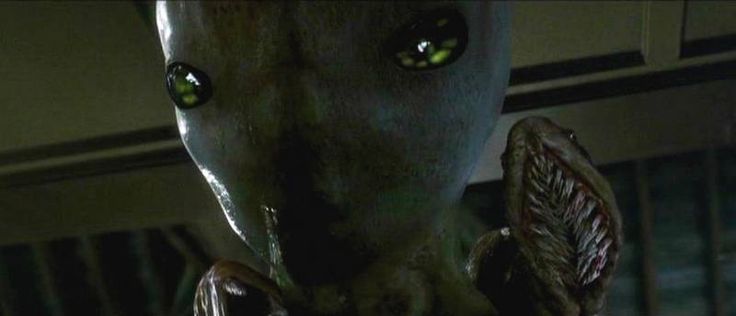A true master of horror, Stephen King originally brought us ‘Dreamcatcher,’ the captivating tale of aliens and enduring friendships, in written form in 2001. In a mere two years, it was adapted for the big screen by William Goldman and Lawrence Kasdan. Sadly, a decent amount of the movies made from King’s literature end up being, shall we say, sub-standard. This may be due to the simple fact that the genesis of the films are the written works, which are in and of themselves so fabulous to begin with; a high bar is automatically set. There are some King movie adaptations that rise to the top, such as ‘The Shining’ and ‘Stand by Me.’ Unfortunately, ‘Dreamcatcher’ is not one of them.
The movie is lengthy, at over 2 hours long, with the first 30 minutes dragging us through the slow process of character development. We are introduced to four childhood friends: Henry (Thomas Jane), Pete (Timothy Olyphant), Beaver (Jason Lee), and Jonesy (Damian Lewis), who are now adults that have a special connection to each other along with the ability to read minds. Not your average group of buddies. They venture to a cabin in Maine for an annual trip that ends up being anything but ordinary.

Beaver and Jonesy find a man lost in the woods and bring him back to their cabin. The problem with this: the man’s stomach is distended, he is constantly belching and farting, and he has a mysterious patch of red spreading on his face. Warning signs to cut and run if you ask me, but our heroes, being good Samaritans, try to take care of him. Soon he visits the bathroom and literally dumps an otherworldly creature, known as the Ripley, in the toilet (it was named after the character in the ‘Alien’ movies, of course). It’s a vicious, teeth-baring worm that is used for spreading the infection of an alien race. There is also a bigger alien, “Mr. Gray,” who is a grown-up version of the Ripley, but it projects to humans as a tall, gray alien with small, green eyes. This alien eventually inhabits Jonesy’s body and speaks with an annoying British accent. Not very scary, if you ask me.
The character who provides the link between the four friends and the aliens is a mentally challenged boy who goes by the name of Duddits. He was the one who gave the friends their gifts, and he plays a pivotal part in the end of the movie.
The big name actor in this film is Morgan Freeman. However, he doesn’t show up until 45 minutes into the movie, complete with a set of wild, bushy eyebrows to go with his crazy persona of Col. Abraham Curtis, a man who has lost his mind after battling the aliens for the last 25 years. Tom Sizemore gives a good performance as Owen, Col. Curtis’ right-hand man.
As the story progressed, I found myself wondering where all of the aliens were. Throughout the film there were numerous cheesy phrases, mostly delivered by Beaver; Jason Lee, to be honest, was not able to pull them off without them sounding forced and awkward. The name of the military outfit that heads up this dilemma is the Blue Unit. Automatically my mind clicked on the now defunct Project Blue Book, which was a real government faction formed for the purpose of studying reports of UFO’s. Coincidence? Maybe.
Lacking in suspense, the bulk of the gore can be attributed to the bathroom scene. This is where we learn the exit route of the anal-dwelling Ripleys. Even with the possibilities offered in the novel, there is little suspense in the film.
Oddly-placed flashbacks and a slow pace left me frustrated and ready to cut my losses. It felt like forever before I saw a truly gripping scene, and that was the above mentioned bathroom/alien birth moment. There is something to be said about aliens exiting the back door instead of entering. The flatulent fun from the two Ripley-gestating victims had me snickering, but I’m not sure that was the emotion intended. Perhaps a television mini-series would have served as a better adaptation of the novel.

There’s not a lot of reality to four telepathic friends who collectively save the world. Maybe some people can believe in these aliens, but how probable is it that in twenty-five years of their visits, not a word has been leaked to the public? Also, timing was everything in this story and the possibility of all of the necessary occurrences falling into place is far-fetched, at best. Now, don’t get me wrong: aliens taking over the world is not a new concept, but the film/book’s take on it is fairly unique. The corrupt military aspect has also been reproduced countless times in pop-culture entertainment, which makes for predictability. The quartet of friends and an endearing Duddits serve as fresh turns in a jerky, inconsistent plot. Again, I think it was simply too much information to cram into a feature-length movie.
There are two areas in the presentation of the film that I would like to specifically mention. The first is that the special effects used to create Mr. Gray, the first time we see him in the cabin, were very good. However, some of the other CG heavy areas in the film lacked the definition and clarity that was present with Mr. Gray. With a budget of $68 million, it often felt like things could have been stepped up a notch or two, visually speaking. A fascinating and successful translation to film was Jonesy’s memory warehouse. This is a place in his mind where all of his memories are stored and it served as a great visual.
All in all, sadly, it’s fair to say I was more than disappointed with the movie version of ‘Dreamcatcher.’ It isn’t the worst King-to-film adaptation I’ve seen, but it definitely wasn’t the best.


